In early 2024 we were finally able to do the trip we had initially planned in April of 2020 – that trip was cancelled for obvious reasons.
After a very long day of travelling, we arrived in Guatemala city after 9PM and went directly to the hotel to sleep. The next day, Antonio came to pick us up for a 6 hour drive to Copan Ruinas in Honduras – our first visit to Guatemala was very short! It was a good opportunity to get to know the guide who would be with us for the next 13 days.
Copan was a major settlement of the Mayas during the “Classic Mayan” Period (250 to 900 AD). It started to decline in the early 800’s and was completely abandoned by 1000 AD, probably due to the lack of drinking water.

This is a model of what the main area of Copan is thought to have looked like at the height of its development. Only a few of the temples and buildings have been restored to this date for lack of funds and manpower. In the middle of the model, at numbers 2 and 3 you can see two of the highlights we will see again later.

Before we made it to the ruins, we ran into local wildlife – there were several beautiful macaws hoping for a handout.

Copan does not have the spectacular temples and buildings that Tikal can boast about. It is known for the stelae representing its successive rulers. Copan has the distinction of having been ruled by 16 members of the same family (or clan) between 400 and 825 AD. These are just two examples of these stelae that were very well described by our local guide. The front shows a portrait of the current ruler while the sides are filled with hieroglyphics about his life and times.

The preservation of these stelae is quite extraordinary; the one on the left still had some of the original paint on it. The quality of the carving is also unique to Copan.

There are many other sculptures that have helped archeologists to piece together the history of the site, but also the history of the Mayas as there is evidence that the various settlements did communicate with each other (and there were occasional conflicts were one clan ‘conquered’ another city) and installed their own ruler. This did not happen to Copan as was mentioned earlier.
Just for orientation, the view above and below are roughly from the number 1 in the model I showed at the top of this post; the view below is looking towards 2 and 3.

The main plaza is surrounded by temples. We learned that temples became higher and higher because each ruler would build “his own” temple on top of the one built be his predecessor. They kept the stelae, but seemed to want to erase all other traces of their father or uncle, depending on how the succession went.

Above are two of the treasures of Copan. In the foreground is the perfectly preserved ball field (Item 2 in the model). In the background, on the left, is the hieroglyphics staircase (Item 3 in the model) which is now covered to protect it from the rain as it was eroding the steps.

The staircase is absolutely unique in the Mayan world. Each of the 63 remaining steps is decorated in hieroglyphics which describe the history of the site and the different generations of rulers.
For many years, visitors were allowed to climb the staircase and look at the designs up close. The authorities have decided that this was causing too much damage and have closed it, and covered it to better protect it.
You may have to open the image below and zoom in to be able to read this description. It is a good read as it tells you the efforts that have been done to renovate, save and protect this unique staircase.

We had a very pleasant walk through the site – several temples have been restored (essentially dug up from under the vegetation and reassembled as best as possible).

Only the base of the temple above could be recovered. The rest of the original stones were probably used in more recent construction in the area.

Here is a view from above of the ball field (a little over exposed, I realise), and the staircase.

There were more macaws throughout the site. These two seemed to be a couple – macaws mate for life.

Not sure what the story is here – I just thought I was lucky to see 4 macaws in the same tree.

Just outside the park with the ruins of Copan, there is a museum where they have gathered some of the best pieces that have been restored to date. Above is the former facade from a house in the residential district. Where they could, they used the original stone and they added new stones to make it whole. The inset shows a close-up of the figure above the door which is remarkably well preserved and detailed.

The flying bat was the symbol of the city of Copan.

We thought we had seen a lot of macaws in one tree at Copan. The next day at breakfast, we had a better spectacle. They came in mass and settled all around us, very noisy too. There are seven visible in this photo.
We went to visit a local village. Fortunately, Antonio spoke 4 of the eight known Mayan languages and so he was able to communicate with the inhabitants who did not speak English or Spanish. We were immediately surrounded by local kids who dragged us towards their house where we met more of the family.

One of the local specialties are dolls made from dried corn husks – one lady made a doll as we watched. It only took her a few minutes. She used corn husks that had been pre-dried and dyed in different colors. You can see another doll being shown in the photo below.

We ended up buying two of them more as a token of appreciation for the demonstration. They actually could make quite nice Christmas tree decoration …

Our last stop in Honduras was “Las Sepulturas” or the cemetery in English. However, the archeologists have since found out that the name is not appropriate at all as this area was mostly residential for the wealthier members of Copan society. Of particular interest is the Palace of the Skyband Bench, described above and shown below.

The Celestial Bench show figures for the four seasons (one is below) topped with hieroglyphs and drawings of every day life during those seasons. The decorations are amazing and my poor photos do not do it justice at all.

As in the Main Copan site, probably less than 20% of the site has been restored with many temples and houses still left in the state they were found, invaded by nature. On a cool day, with the shade of the trees, it made for a very pleasant walk.

We also visited a local rehabilitation center for macaws. We had seen the red macaws in freedom, and there were some here too. I concentrated on the ‘other’ animals we found, like the green macaws below

of the blue and gold macaws. All of these were brought to the center with some disability – a lot will not be able to return to nature as they will not be able to fly or fend for themselves anymore; those who can, however, are released once they recover.
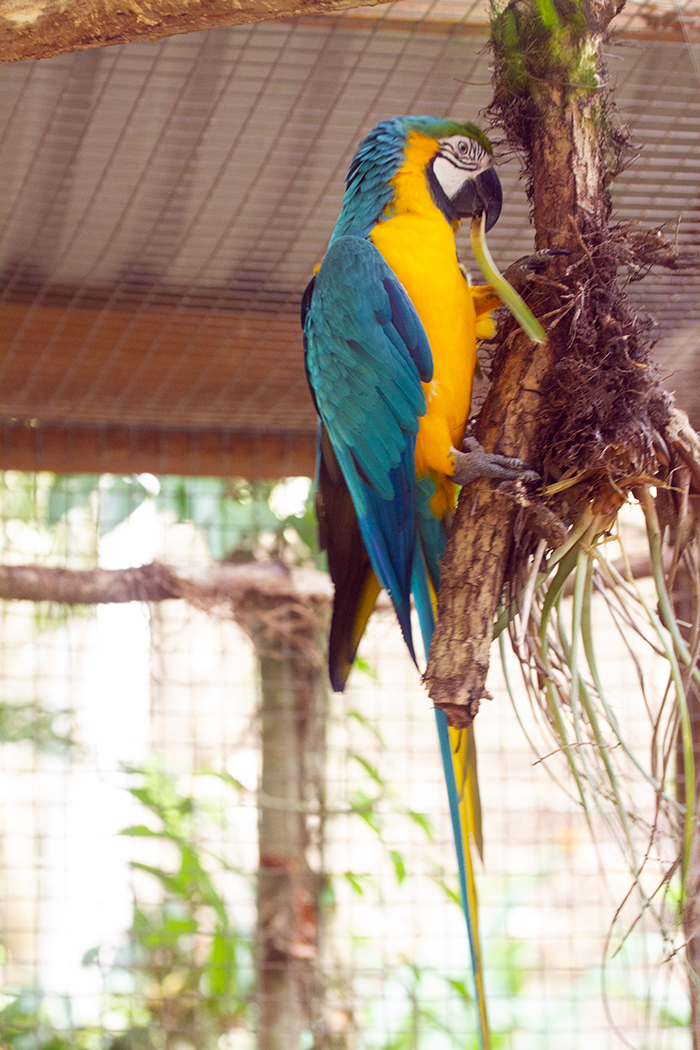
While we were walking around, we ran into this beautiful little bird. I am not sure what it is – could be an oriole, not from Baltimore.

There were a few Toucans. We saw some in Costa Rica (in 2019), but none free in Honduras or Guatemala.

I loved these two owls. I think they are Barn Owls, sound asleep.

There was food laid out everywhere to attract birds. This two macaws were having a feast.
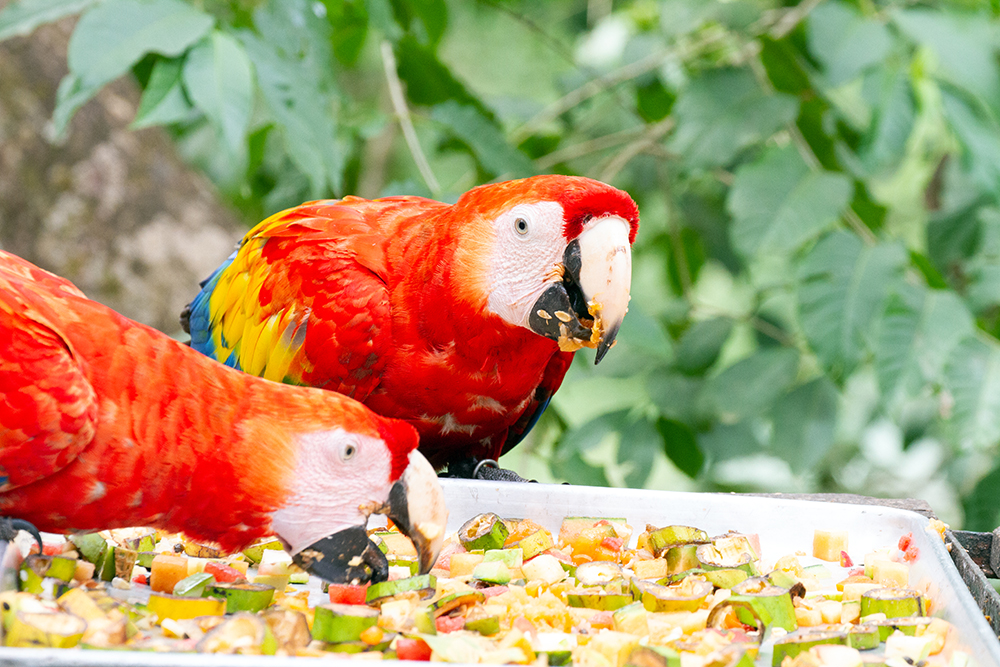
After three wonderful days in Copan Ruinas and Honduras, we headed back to Guatemala and right over the border, we stopped in Quiriga, another Classic Mayan settlement.

The whole area was very beautiful and pleasant to walk through. There were stelae here too which represented former rulers – they were not as elaborate and informative as those we have seen in Copan.

Below is a giant figure of a snake, the symbol of Quiriga. Antonio, our guide could spend hours describing the hieroglyphs on the stelae and the meaning behind the symbols used. He is a true Mayan scholar with knowledge gained by his own studies and his involvement with several universities, including the University of Bonn, Texas and British Columbia. One of the guides called him “Professore” as he is know by all to share his knowledge, particularly when new discoveries are made. We very much enjoyed our conversations with him.

We ran into leaf cutter ants. The photo on the left is a close up of the ants on a tree trunk – even then, you cannot see the ants, just the pieces of leaf that they are carrying. Each piece of green leaf hides one or two ants, as shown on the inset on the lower left. The right side of the photo, is the trace that these ants have left in the grass – they have been doing this for so long that they have worn out the grass, just like we do when we cut across a lawn in a park (hint!)
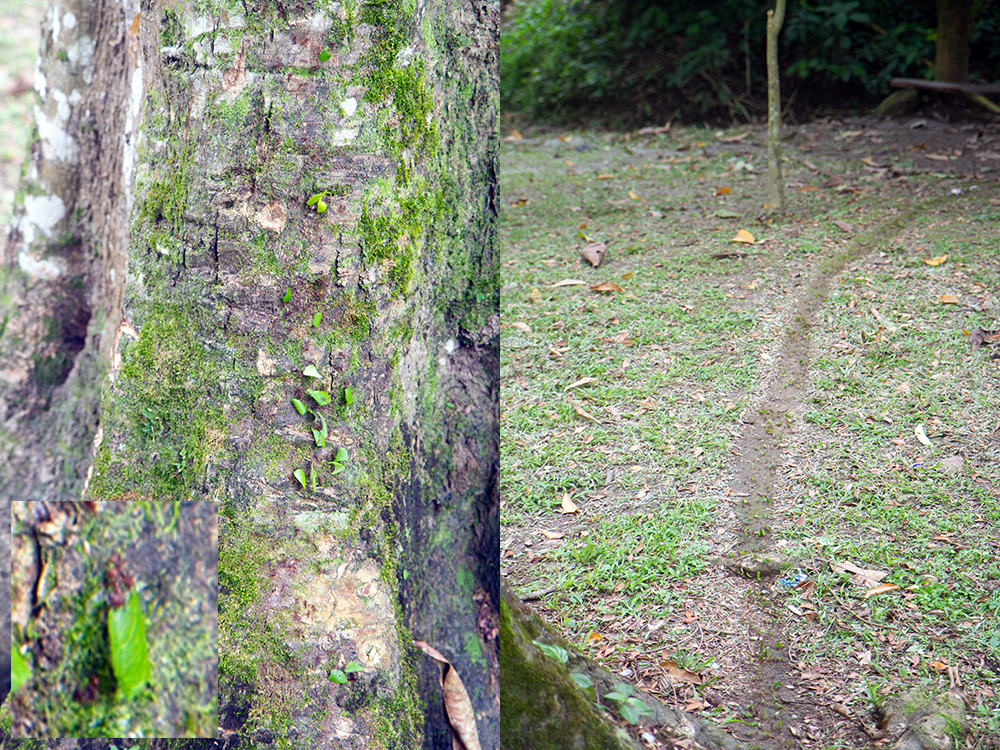
After Quiriga, we continued our drive towards our ultimate goal that day: Livingston. Livingston is actually on the Caribbean Sea. It is either a very long and tortuous drive to go there, or you stop at Rio Dulce and take a fast boat down the river.

That is what we did. Along the way, in the river and lake that we crossed, we ran into cormorants, beautiful white herons and even an iguana perched high on a tree. We had already seen these iguanas in Costa Rica, so it was not a total surprise to see how easily they climb trees.

We also saw other birds – top left is probably a Red Rail, top right and bottom left are pelicans and the bottom right is a common gallinule – I love the reflection of that one in the water.

As we approached Livingston, we saw a large colony of terns. As we got closer, and as I was taking photos, they suddenly got startled and started to fly off in all directions. I think the effect is not too bad.
We only staid one night in Livingston and then headed towards Flores. Most people will probably not know why we are going there. It was not to visit Antonio’s family, even though we had lunch at the restaurant owned and operated by his middle son. This is where Antonio was born and raised.
This is also the gateway to Yaxha, another set of Mayan ruins. Please remember the title of this post: Ancient Mayas. We saw a lot of old stones.
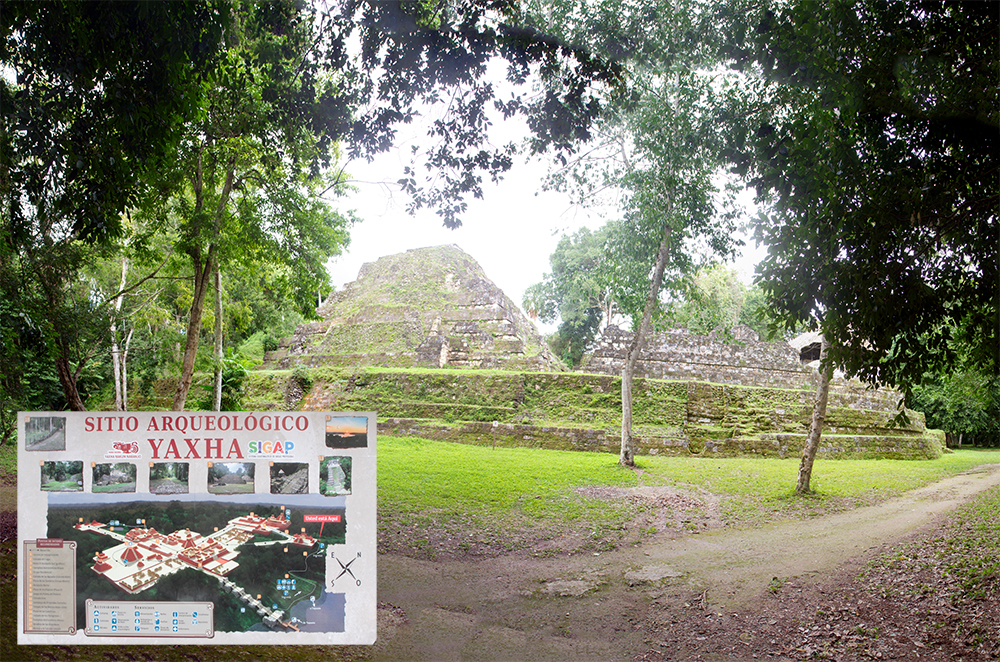
Each of the sites we have visited has its own character – very difficult to render that in photos, or even with the text. Yaxha is off the typical tourist tracks as it is very difficult to get there. Antonio had to drive for about an hour on a dirt road that was not very good quality – we almost needed a 4-wheel drive vehicle to get there. It is clear that the large tourist busses cannot make it.
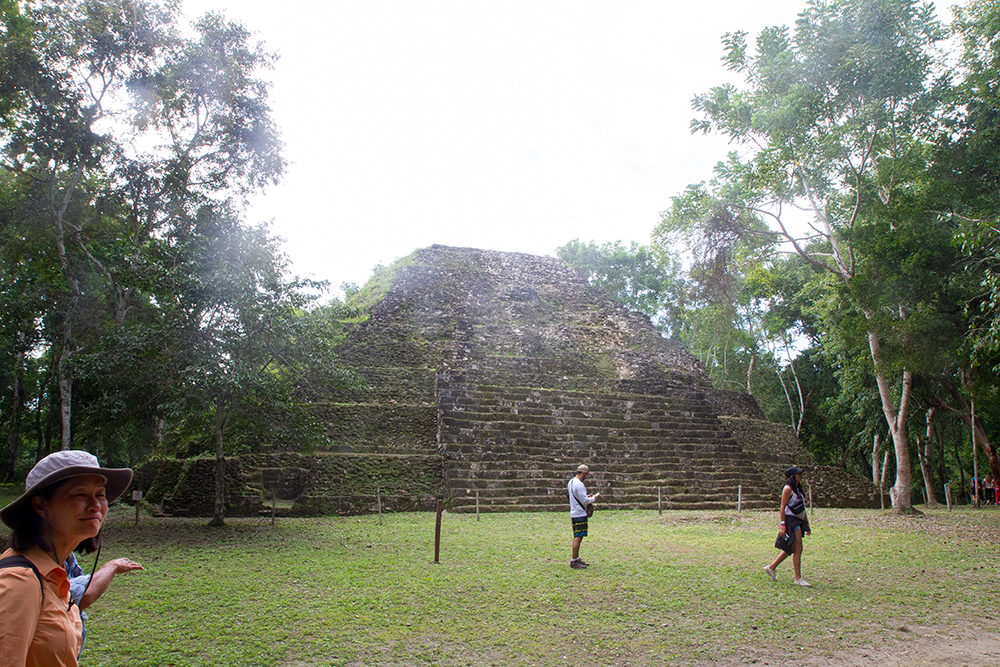
We were always very lucky as we rarely had any crowds in the places we visited.

The buildings here were generally lower than in other sites. Most looked like residential rather than temples or palaces.

We saw this monkey in a strange pose – as I was taking his photo, he decided to jump to the next tree – shy I guess.

As I mentioned before, each ruler had a tendency to build a new temple on top of the one built by his predecessor in order to ‘erase’ his trace from history. In this particular temple, the archeologists had dug a trench that shows three layers of stairs. The top one is the latest and the two older ones are shown by each of the arrows. They built on top of the old temples, but not a lot taller or bigger.

Here are several pyramids that have been well restored

Yaxha is know for its sunset temple. We, along with 60-80 other people waited for sunset while sitting on top of this one temple. However, this photo is taken well before sunset. There was a large rain storm in the distance, completely covering up the sun and we really never had a good sunset.

The other reason people come to Flores (actually, the main reason to come here) is to visit Tikal. When I think of the Mayas, two sites come to mind: Chichen-Itza in the Yucatan peninsula of Mexico and Tikal in Guatemala. This is the main reason why we decided to come to Guatemala.

Local fauna, not at all bothered by our presence.

The typical photo of Tikal – very tall, very steep pyramidal temple. These are much steeper than the pyramids in Egypt, or even the Toltec and Aztec constructions near Mexico City.

Here is proof that there was communications between the various Mayan sites. The circle symbol is typical of Palenke, another Mayan city in southern Mexico. It is found here on a building that could have been the local “Embassy” of Palenke to Tikal. Sometimes, the influence of one site over another is due to wars and conquest, but most often these were rather peaceful exchanges.

One of the main plazas in Tikal. The site is huge, less than 15% explored and restored. If you are an archeologist and want to have work for many life-times, come to Guatemala – you need to bring your own funds too!

The central plaza of Tikal

These are the pyramids typically used on the publicity posters for Tikal and Guatemala

I am just hanging here, relaxing!

The view from one temple looking back at the rest of the site. I did not want to ruin the photo with large arrows (again) – if you look carefully, there is another temple visible at about 4:30 from the one sticking out of the trees. There are several people on top of that one. There is another platform to the right of the tall temple, after the first mound of trees. These temples used to be much taller but have not been reconstructed to their former height as not enough of the original stones have been found.
From Tikal we moved to Antigua, about 1 hour north of Guatemala City. Here we were in the middle of current Mayas who have continued some traditions since the times of the Classical Mayas. It will be an opportunity to see how they have adapted to the modern world and yet kept alive their ancient traditions. This will be the subject of a future blog.
(14 Page Views)

Love getting a glimpse of the wildlife!